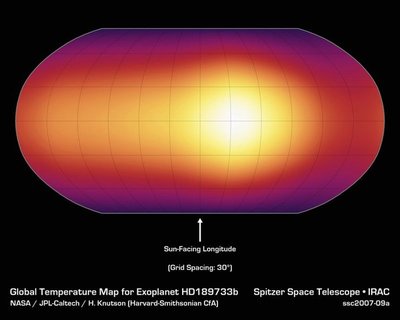May 17, 2007
Astronomers create rough map of planet
For the first time, astronomers have created a rough map of a planet orbiting a distant sun-like star, using a technique that eventually could allow mapping of planets with Earth-like characteristics. The planet is a gas giant, slightly larger than Jupiter, and lacks a solid surface, so the map shows cloud-top features.
Using the infrared Spitzer Space Telescope, the astronomers detected a bright hot spot where the temperature is highest on the planet, known as HD 189733b. That spot is perhaps 20 degrees of longitude away from the location where the star shines most intensely on the planet.
“That’s evidence that there are very strong winds carrying the heat from the point on the planet closest to the star and releasing it downstream at the hottest point,” said Eric Agol, a UW assistant professor of astronomy and a co-author of the study, which appears in the May 10 edition of Nature.
The scientists examined the planet using Spitzer’s Infrared Array Camera, which made it easier to separate the planet’s infrared signals from those emitted by the star it is orbiting. During 33 hours, the team collected more than 250,000 data points, essentially allowing the creation of a longitudinal map composed of infrared strips running pole to pole. The strips then were assembled into an overall picture.
“We started out observing the night side of the planet and then as the observations progressed, the planet became brighter as the day side turned toward us,” said Agol.
From the observations, Agol — who recently was awarded an $800,000 career grant over five years by the National Science Foundation to study extrasolar planets — realized it should be possible to create a heat map of the planet looking at what the brightness should be at each slice of longitude.
“We felt a little like Galileo must have felt when he first glimpsed Jupiter through the eyepiece of his telescope,” said Heather Knutson, a Harvard University graduate student who is the lead author of the Nature paper.
Nicolas Cowan, a UW astronomy doctoral student, also among the paper’s nine authors, was the first team member to create a map using the data.
While the Spitzer telescope is only able to map large worlds too hot for liquid water or life, the James Webb Space Telescope scheduled for launch in 2013 could use the same technique to map Earth-like planets.
HD 189733b orbits just 3 million miles away from its star, which is slightly cooler and less massive than the sun and is about 60 light-years from Earth. The planet’s hottest spot is 1,700 degrees F and the intense heat is circulated by winds perhaps as strong as 6,000 miles per hour. The same side of the planet always faces its sun, but the powerful winds mean even the dark side of the planet is about 1,200 degrees F.

